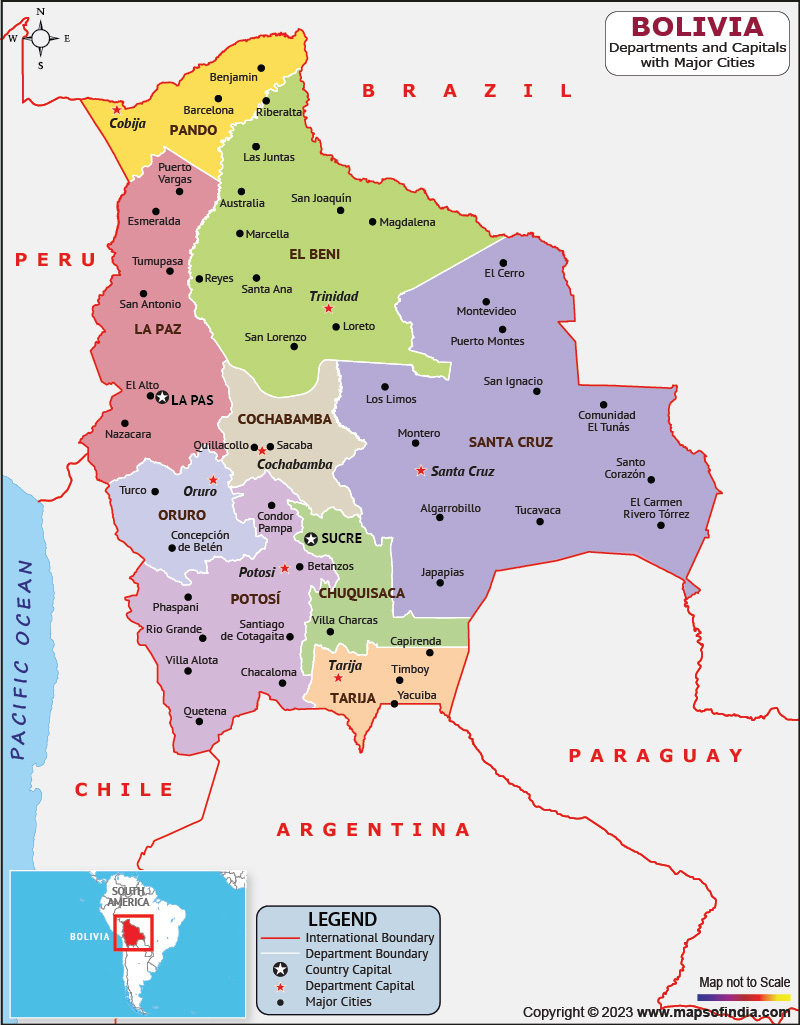Bolivia is a nation situated in the South American continent, bordered by Paraguay to the southeastern front, Brazil to the northern and eastern front, Chile to the southwestern front, Peru to the northwestern front, and Argentina to the southern front. The country has a diverse geography, including the Andes Mountains, the Altiplano plateau, the Amazon rainforest, and the Chaco region.
History:
Bolivia's history dates back to pre-Columbian times, with the region being inhabited by various indigenous peoples. The Inca Empire dominated the region in the 15th century, and the Spanish conquered the area in the 16th century, establishing the Viceroyalty of Peru. Bolivia gained independence in 1825, and the country was named after Simon Bolivar, a revolutionary who played a significant role in the fight for independence throughout South America.
Culture:
Bolivia is known for its rich and diverse culture, with a mix of indigenous, Spanish, and African influences. The country has 36 indigenous ethnic groups, each with their unique traditions and languages. Bolivian cuisine varies depending on the region but is often based on potatoes, corn, and meat, with dishes like salteñas, a type of baked empanada filled with meat and vegetables, and pique macho, a hearty dish of beef, potatoes, and vegetables.
Bolivia is also famous for its traditional clothing, including the colorful and ornate skirts and shawls worn by indigenous women in the highlands. The country is known for its festivals and celebrations, including the famous Carnival of Oruro, a UNESCO World Heritage event that combines indigenous and Catholic traditions.
Language:
The official language of Bolivia is Spanish, but there are also 36 recognized indigenous languages, including Quechua, Aymara, and Guarani. Many Bolivians are bilingual, speaking both Spanish and their native language. Spanish is the dominant language in urban areas, while indigenous languages are more commonly spoken in rural communities.
Geography:
Bolivia's geography is diverse and includes the Andes Mountains, the Altiplano plateau, the Amazon rainforest, and the Chaco region. The Andes Mountains, which run through the western part of the country, include several peaks over 6,000 meters, including Mount Illimani and Mount Sajama. The Altiplano plateau, located in the Andean highlands, is the world's highest plateau, with an average elevation of 3,750 meters.
| Official Name | Plurinational State of Bolivia |
| Capital | La Paz |
| Population | 12054379 |
| Area | 1,098,581 km2 |
| Currency | Boliviano |
| Religion | Christianity |
| Language | Spanish |
| Major Cities | Sucre, Potosi, Cochabamba |
FAQs
Q1: What is the capital of Bolivia?
The capital of Bolivia is La Paz, which is located in the western portion of the nation.
Q2: What is the currency of Bolivia?
The main currency of the nation is the Boliviano, which is abbreviated as BOB.
Q3: What are some popular tourist attractions in Bolivia?
Bolivia has several popular tourist attractions, including the Salar de Uyuni salt flats, Lake Titicaca, the Yungas Road, the Tiwanaku ruins, and the Amazon rainforest.
Q4: What is the climate like in Bolivia?
Bolivia's climate varies depending on the region, with the Andean highlands having a cooler climate, the Amazon rainforest having a humid tropical climate, and the Chaco region having a hot and dry climate.
Last Updated on: April 24, 2023
